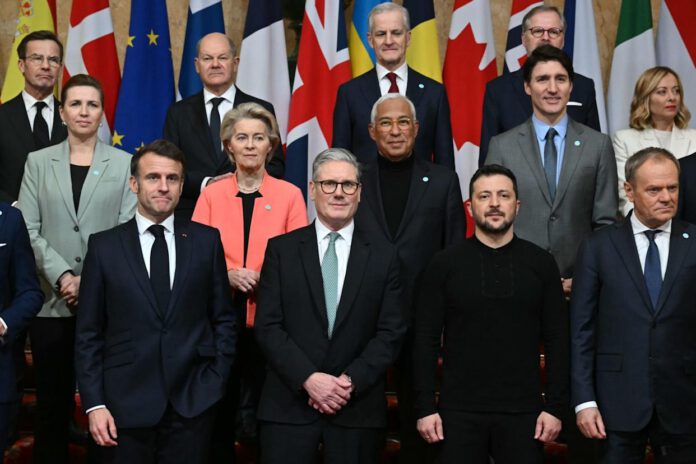
In February 2025, the United States and Russia abruptly sidelined both the EU and Ukraine, launching direct negotiations over the Russia-Ukraine conflict. On the 28th, U.S. President Donald Trump met publicly with Ukrainian leader Volodymyr Zelensky. The meeting quickly turned confrontational, leading to the suspension of a planned mineral deal with Ukraine and the collapse of proposed Russia-Ukraine ceasefire talks.
Three days later, the European Union responded with the largest military spending increase in its history — the €800 billion Re-arming Europe program. Ironically, this long-delayed initiative was hurriedly launched under the shadow of U.S.-Russia talks.
This abrupt shift underscores Europe’s increasingly passive role in the evolving security landscape and highlights its deeper structural reliance on the United States.
After World War II, Europe was mired in recession. To aid recovery, the U.S. launched the Marshall Plan in 1947, injecting $13.15 billion into 16 Western European countries. In return, recipients committed to rebuilding their military industries and aligning with U.S. global strategy.
The 1949 creation of NATO marked the start of a joint defense system between Europe and the U.S. Over time, the U.S. established around 300 military bases across Europe, stationing more than 100,000 troops. By outsourcing its defense and integrating with NATO, Europe developed a security model heavily reliant on the American umbrella.
The EU’s creation in 1993 introduced the Common Foreign and Security Policy (CFSP), incorporating defense into its framework. The 1999 Cologne Summit advanced this with the European Security and Defense Policy (ESDP), signaling a desire to reduce dependence on the U.S. and build autonomous military capabilities.
In 2017, the launch of Permanent Structured Cooperation (PESCO) brought 23 member states together on 47 joint defense projects. Yet in practice, the absence of a clear threat and continued U.S. security support led Europe to prioritize peacekeeping and counter-terrorism. Defense spending fell from 2.5% of GDP after the Cold War to 1.5% by 2021, as focus shifted to welfare and development.
The 2022 Russia-Ukraine war jolted Europe from this “half-awake” state. Most EU countries, as NATO members, backed Ukraine with sanctions, weapons, training, and intelligence, in coordination with the U.S. Military spending rose 13% in a year — the highest since the Cold War.
Yet despite crossing the 2% GDP defense benchmark, Europe could only meet 20% of its own military production needs, remaining 80% reliant on U.S. high-end weaponry. This exposed the fragility of Europe’s defense autonomy and forced a reckoning with the risks of long-term reliance on the U.S. in an increasingly volatile world.
Military spending has long been a source of tension between the U.S. and Europe, reignited in 2017 when Donald Trump labeled NATO “obsolete” and demanded Europe shoulder more of the defense burden. In response, EU countries gradually raised their spending targets, some reaching up to 3% of GDP. Yet U.S. pressure extended beyond defense: in 2023, the Biden administration’s Inflation Reduction Act offered massive subsidies to attract clean energy and semiconductor firms, leading to a 47% surge in EU investment into the U.S. and further weakening Europe’s industrial base. In both military and economic spheres, Washington’s shifting posture has left Europe more exposed.
Trump’s return in 2025 deepened this vulnerability. He immediately raised NATO spending demands to 5% of GDP and negotiated a separate peace deal with Moscow, bypassing NATO and Ukraine. Days later, the EU unveiled its largest-ever military investment—the €800 billion Re-arming Europe plan—seen by many as a defensive response to U.S. coercion. The plan sparked debate across the continent. The IMF warned that if the EU raised defense spending to 3% of GDP, regional growth could slow by 0.4 percentage points over five years due to reduced social and climate investments.
Internally, the EU’s fiscal posture has shifted. Germany suspended long-standing spending caps, proposing a €500 billion fund for infrastructure and climate goals. The Commission followed with its rearmament plan, proposing exemptions for defense spending from deficit rules, and launching the €150 billion SAFE loan initiative for joint procurement. However, consensus remains elusive. Northern and Eastern states like Lithuania support high military spending, while Southern countries remain cautious. Even Germany and France diverge: Berlin favors fiscal relaxation; Paris stresses investment-led growth.
Efforts to localize arms production are growing, yet EU defense remains heavily dependent on U.S. suppliers. From 2020 to 2024, U.S. firms accounted for 64% of European NATO arms imports. SAFE loans aim to shift procurement toward European sources, but breaking entrenched supply chains will take time. Meanwhile, the EU continues to lag in critical technologies—from hypersonic missiles to AI-driven defense systems. While programs like EUDIS and HEDI seek to close the gap, Europe’s defense R&D remains underfunded.
The EU’s recent defense reform signals not only a shift in fiscal priorities but also deeper economic and political realignments. However, this effort is fraught with challenges. Economically, higher military spending risks fueling sovereign debt crises, especially in heavily indebted countries like Italy, while squeezing budgets for social welfare and green initiatives. Defense contractors may profit, but the public faces greater burdens.
Politically, internal divisions persist. Countries like Poland and the Netherlands remain aligned with U.S. defense strategies, while France and Germany push for European strategic autonomy. This rift weakens collective action and undermines the EU’s global influence.
Globally, the shift from globalization to regionalization adds further pressure. As the U.S. embraces regional competition, the EU may follow, risking greater global fragmentation. Tensions with China and increased U.S. alignment could draw Europe into broader geopolitical conflicts, especially in the Indo-Pacific.
Despite bold rhetoric on strategic autonomy, Europe’s dependence on the U.S. persists across military, economic, and technological dimensions. Without greater internal cohesion and capability, the EU’s defense transformation risks becoming reactive and externally driven—more a symptom of shifting U.S. priorities than a sign of genuine European empowerment.
Source:Yahoo, France 24, Le Monde, BBC, Guancha



